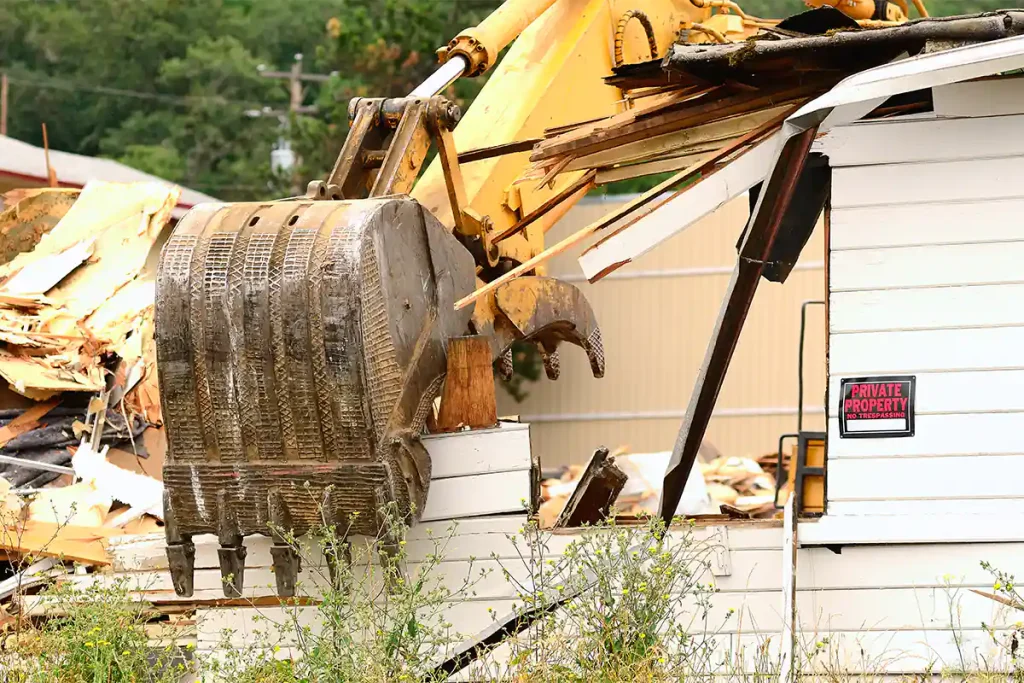What is Demolition?
Demolition involves safely and efficiently removing existing structures. This can range from small residential homes to large commercial buildings.
There are several types of demolition with each suited for different structures and project requirements:
- Interior: This involves removing interior structures while preserving the exterior. It’s often used for renovations.
- Selective: Only specific parts of a building are removed while the rest is preserved.
- Deconstruction: A methodical process where structures are taken apart piece by piece, often to salvage materials.
- Mechanical: Heavy machinery, like excavators and wrecking balls, is used to tear down the structure.
- Implosion: This controlled demolition uses explosives to bring down large structures quickly and safely.

Why You Might Need Demolition
There are many scenarios that call for demolition. These can include clearing a site for new construction, removing hazardous materials, or renovating an outdated space. It can also be necessary when a building is structurally unsafe or when it costs more to repair than to replace.
Planning
Before you begin thorough planning is essential. Here are the key steps involved:
- Assessment and Permits: Hire a professional to assess the structure. They will identify any hazardous materials, such as asbestos, and help you obtain the necessary permits.
- Choosing your Company: Look for reputable companies near you. Check their credentials, experience, and reviews. Make sure they comply with local laws and regulations.
- Cost Estimation: Get a detailed estimate of the costs involved. This should include labour, equipment, permits, and waste disposal.
- Site Preparation: Before beginning, utilities must be disconnected, and the site secured to ensure safety.
The Process
Once planning is complete, the actual work can begin. This process varies depending on the type of project but typically includes the following steps:
Pre-Inspection
Before any work starts, a final inspection ensures that all safety measures are in place, and the site is ready.
Hazardous Material Removal
Any hazardous materials, such as asbestos or lead, must be safely removed before commencement. This is crucial for the safety of workers and the surrounding environment.
Structural
The main event is the structural demolition on a structure here in Sydney, where the building is taken down. This can involve heavy machinery or controlled explosions, depending on the project's needs.
Debris Removal & Site Cleanup
After the structure is demolished, all debris must be cleared from the site. This includes sorting and recycling materials like metal and concrete, where possible.
Final Site Inspection
A final inspection ensures that the site is clean and ready for whatever comes next, whether it’s new construction or a vacant lot.
Choosing the right contractors
Selecting the right demolition companies near me is crucial for a successful project. Here are some tips for finding the right team:
- Experience: Choose contractors with a proven track record in the type of project you need.
- Safety Record: Ensure they prioritise safety and have a good safety record.
- Licenses and Insurance: Verify that they have the necessary licenses and insurance.
- References: Ask for and check references from previous clients.
Safety Measures
Safety is a top priority in all projects. Here are some of the key safety measures taken:
- Personal Protective Equipment (PPE): Workers must wear appropriate PPE, including helmets, gloves, and masks.
- Safety Barriers: Secure barriers are set up to protect workers and the public.
- Dust Control: Water sprays and other methods are used to control dust emissions.
Environmental Considerations
Demolition can have significant environmental impacts, so it’s essential to minimise these through:
- Recycling Materials: Salvaging and recycling as much material as possible reduces waste.
- Proper Disposal: Ensuring hazardous materials are disposed of properly to prevent environmental harm.
This is a complex process requiring careful planning and execution. By understanding the steps involved and choosing the right contractors, you can ensure your project is completed safely and efficiently.
Whether you’re clearing the way for something new or removing a hazardous structure, knowing what to expect can help you navigate the process with confidence.
Remember, always work with experienced professionals and prioritise safety and environmental considerations to achieve the best results. If you’re ready to start your next project, begin by researching demolition contractors near you to find the right fit for your needs.
